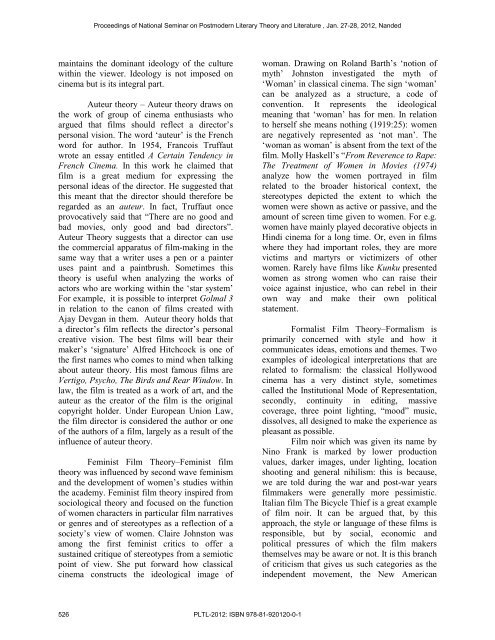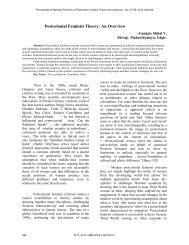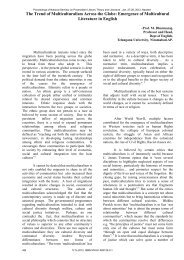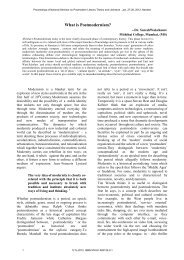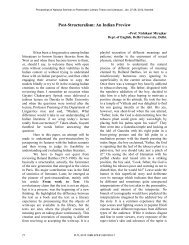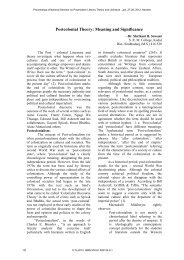Proceedings of National Seminar on Postmodern ... - Igcollege.org
Proceedings of National Seminar on Postmodern ... - Igcollege.org
Proceedings of National Seminar on Postmodern ... - Igcollege.org
Create successful ePaper yourself
Turn your PDF publications into a flip-book with our unique Google optimized e-Paper software.
<str<strong>on</strong>g>Proceedings</str<strong>on</strong>g> <str<strong>on</strong>g>of</str<strong>on</strong>g> <str<strong>on</strong>g>Nati<strong>on</strong>al</str<strong>on</strong>g> <str<strong>on</strong>g>Seminar</str<strong>on</strong>g> <strong>on</strong> <strong>Postmodern</strong> Literary Theory and Literature , Jan. 27-28, 2012, Nanded<br />
maintains the dominant ideology <str<strong>on</strong>g>of</str<strong>on</strong>g> the culture<br />
within the viewer. Ideology is not imposed <strong>on</strong><br />
cinema but is its integral part.<br />
Auteur theory – Auteur theory draws <strong>on</strong><br />
the work <str<strong>on</strong>g>of</str<strong>on</strong>g> group <str<strong>on</strong>g>of</str<strong>on</strong>g> cinema enthusiasts who<br />
argued that films should reflect a director’s<br />
pers<strong>on</strong>al visi<strong>on</strong>. The word ‘auteur’ is the French<br />
word for author. In 1954, Francois Truffaut<br />
wrote an essay entitled A Certain Tendency in<br />
French Cinema. In this work he claimed that<br />
film is a great medium for expressing the<br />
pers<strong>on</strong>al ideas <str<strong>on</strong>g>of</str<strong>on</strong>g> the director. He suggested that<br />
this meant that the director should therefore be<br />
regarded as an auteur. In fact, Truffaut <strong>on</strong>ce<br />
provocatively said that “There are no good and<br />
bad movies, <strong>on</strong>ly good and bad directors”.<br />
Auteur Theory suggests that a director can use<br />
the commercial apparatus <str<strong>on</strong>g>of</str<strong>on</strong>g> film-making in the<br />
same way that a writer uses a pen or a painter<br />
uses paint and a paintbrush. Sometimes this<br />
theory is useful when analyzing the works <str<strong>on</strong>g>of</str<strong>on</strong>g><br />
actors who are working within the ‘star system’<br />
For example, it is possible to interpret Golmal 3<br />
in relati<strong>on</strong> to the can<strong>on</strong> <str<strong>on</strong>g>of</str<strong>on</strong>g> films created with<br />
Ajay Devgan in them. Auteur theory holds that<br />
a director’s film reflects the director’s pers<strong>on</strong>al<br />
creative visi<strong>on</strong>. The best films will bear their<br />
maker’s ‘signature’ Alfred Hitchcock is <strong>on</strong>e <str<strong>on</strong>g>of</str<strong>on</strong>g><br />
the first names who comes to mind when talking<br />
about auteur theory. His most famous films are<br />
Vertigo, Psycho, The Birds and Rear Window. In<br />
law, the film is treated as a work <str<strong>on</strong>g>of</str<strong>on</strong>g> art, and the<br />
auteur as the creator <str<strong>on</strong>g>of</str<strong>on</strong>g> the film is the original<br />
copyright holder. Under European Uni<strong>on</strong> Law,<br />
the film director is c<strong>on</strong>sidered the author or <strong>on</strong>e<br />
<str<strong>on</strong>g>of</str<strong>on</strong>g> the authors <str<strong>on</strong>g>of</str<strong>on</strong>g> a film, largely as a result <str<strong>on</strong>g>of</str<strong>on</strong>g> the<br />
influence <str<strong>on</strong>g>of</str<strong>on</strong>g> auteur theory.<br />
Feminist Film Theory–Feminist film<br />
theory was influenced by sec<strong>on</strong>d wave feminism<br />
and the development <str<strong>on</strong>g>of</str<strong>on</strong>g> women’s studies within<br />
the academy. Feminist film theory inspired from<br />
sociological theory and focused <strong>on</strong> the functi<strong>on</strong><br />
<str<strong>on</strong>g>of</str<strong>on</strong>g> women characters in particular film narratives<br />
or genres and <str<strong>on</strong>g>of</str<strong>on</strong>g> stereotypes as a reflecti<strong>on</strong> <str<strong>on</strong>g>of</str<strong>on</strong>g> a<br />
society’s view <str<strong>on</strong>g>of</str<strong>on</strong>g> women. Claire Johnst<strong>on</strong> was<br />
am<strong>on</strong>g the first feminist critics to <str<strong>on</strong>g>of</str<strong>on</strong>g>fer a<br />
sustained critique <str<strong>on</strong>g>of</str<strong>on</strong>g> stereotypes from a semiotic<br />
point <str<strong>on</strong>g>of</str<strong>on</strong>g> view. She put forward how classical<br />
cinema c<strong>on</strong>structs the ideological image <str<strong>on</strong>g>of</str<strong>on</strong>g><br />
woman. Drawing <strong>on</strong> Roland Barth’s ‘noti<strong>on</strong> <str<strong>on</strong>g>of</str<strong>on</strong>g><br />
myth’ Johnst<strong>on</strong> investigated the myth <str<strong>on</strong>g>of</str<strong>on</strong>g><br />
‘Woman’ in classical cinema. The sign ‘woman’<br />
can be analyzed as a structure, a code <str<strong>on</strong>g>of</str<strong>on</strong>g><br />
c<strong>on</strong>venti<strong>on</strong>. It represents the ideological<br />
meaning that ‘woman’ has for men. In relati<strong>on</strong><br />
to herself she means nothing (1919:25): women<br />
are negatively represented as ‘not man’. The<br />
‘woman as woman’ is absent from the text <str<strong>on</strong>g>of</str<strong>on</strong>g> the<br />
film. Molly Haskell’s “From Reverence to Rape:<br />
The Treatment <str<strong>on</strong>g>of</str<strong>on</strong>g> Women in Movies (1974)<br />
analyze how the women portrayed in film<br />
related to the broader historical c<strong>on</strong>text, the<br />
stereotypes depicted the extent to which the<br />
women were shown as active or passive, and the<br />
amount <str<strong>on</strong>g>of</str<strong>on</strong>g> screen time given to women. For e.g.<br />
women have mainly played decorative objects in<br />
Hindi cinema for a l<strong>on</strong>g time. Or, even in films<br />
where they had important roles, they are more<br />
victims and martyrs or victimizers <str<strong>on</strong>g>of</str<strong>on</strong>g> other<br />
women. Rarely have films like Kunku presented<br />
women as str<strong>on</strong>g women who can raise their<br />
voice against injustice, who can rebel in their<br />
own way and make their own political<br />
statement.<br />
Formalist Film Theory–Formalism is<br />
primarily c<strong>on</strong>cerned with style and how it<br />
communicates ideas, emoti<strong>on</strong>s and themes. Two<br />
examples <str<strong>on</strong>g>of</str<strong>on</strong>g> ideological interpretati<strong>on</strong>s that are<br />
related to formalism: the classical Hollywood<br />
cinema has a very distinct style, sometimes<br />
called the Instituti<strong>on</strong>al Mode <str<strong>on</strong>g>of</str<strong>on</strong>g> Representati<strong>on</strong>,<br />
sec<strong>on</strong>dly, c<strong>on</strong>tinuity in editing, massive<br />
coverage, three point lighting, “mood” music,<br />
dissolves, all designed to make the experience as<br />
pleasant as possible.<br />
Film noir which was given its name by<br />
Nino Frank is marked by lower producti<strong>on</strong><br />
values, darker images, under lighting, locati<strong>on</strong><br />
shooting and general nihilism: this is because,<br />
we are told during the war and post-war years<br />
filmmakers were generally more pessimistic.<br />
Italian film The Bicycle Thief is a great example<br />
<str<strong>on</strong>g>of</str<strong>on</strong>g> film noir. It can be argued that, by this<br />
approach, the style or language <str<strong>on</strong>g>of</str<strong>on</strong>g> these films is<br />
resp<strong>on</strong>sible, but by social, ec<strong>on</strong>omic and<br />
political pressures <str<strong>on</strong>g>of</str<strong>on</strong>g> which the film makers<br />
themselves may be aware or not. It is this branch<br />
<str<strong>on</strong>g>of</str<strong>on</strong>g> criticism that gives us such categories as the<br />
independent movement, the New American<br />
526 PLTL-2012: ISBN 978-81-920120-0-1


